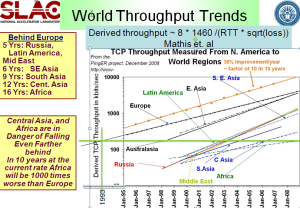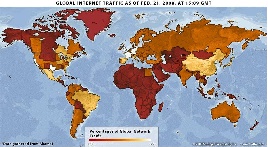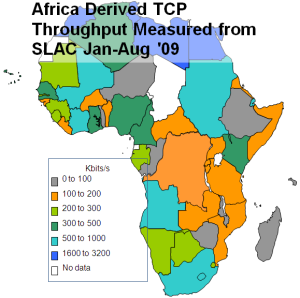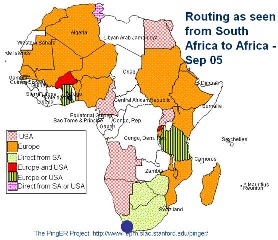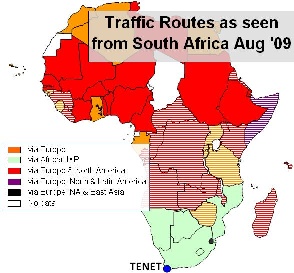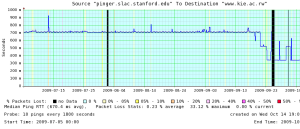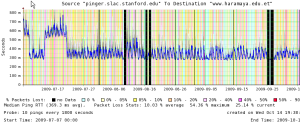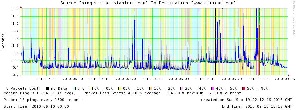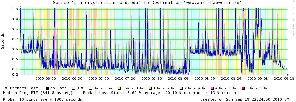...
The derived throughputs measured to Africa from N. America for the last decade are shown below in the left hand figure. It is seen that not only do African sites lag the rest of the world in throughput, being roughly in the state that European sites were over a decade and a half ago, but also they are falling further behind with time.
Throughput from SLAC to Regions of the World | Akamai Global Internet Traffic |
|---|---|
| |
Further, bear in mind that for Africa, Mediterranean countries and South Africa have the better perfomance and E. Africa is the worst off (see the the middle map below). Thus the arrival of a terrestrial submarine fibre cable link to the rest of the world for E. Africa is a very significant development.
...
<ac:structured-macro ac:name="unmigrated-wiki-markup" ac:schema-version="1" ac:macro-id="d9d0f53ca608b9ed-bb7c0024-49ff4b3a-ae0bbb73-794c1b67bcf74773e26745cb"><ac:plain-text-body><![CDATA[ | Throughput from SLAC to Regions of the World | Derived Throughput from SLAC to Africa Jan-Aug '09 [[xlsx | ^africa-thru-aug09.xlsx]] | MinRTT from SLAC - Aug. 2009 [[xls | ^map-africa-minrtt-aug2009.xls]] | ]]></ac:plain-text-body></ac:structured-macro> | |
|---|---|---|---|---|---|---|---|
|
|
The striking number of countries in Eastern and Central Africa with minimum RTTs of >400ms is indicative that they were using GEO-Stationary (GEOS)satellite links.
...
<ac:structured-macro ac:name="unmigrated-wiki-markup" ac:schema-version="1" ac:macro-id="e43e70245f857265-04c7047b-4aea45cc-8a239962-11191ea30a7b3ba5122880d7"><ac:plain-text-body><![CDATA[ | Routing from South Africa to African Countries (Sep '05) | Routing from South Africa to African Countries (Aug '09) [[xls | ^routing-africa-aug2009.xls]] | Routing from Burkina Faso to African Countries (Aug '09) [[xls | ^routing-africa-aug2009.xls]] | ]]></ac:plain-text-body></ac:structured-macro> |
|---|---|---|---|---|---|---|
| |
|
...
More details on the Kenyatta University (www.ku.ac.ke) and Braeburn (elearning.braeburn.ac.ke) links can be found in an email from Kevin Chege of KENET.
...
Rwanda
...
Mozambique
...
Mozambique is connected through the EASSY submarine cable. It appears one of the hosts we measure activated the terrestrial link on ~ 25th August 2010 about a month after the completion of the fibre in July 2010.
...
Rwanda
...
Between the 22nd and 25th of September the RTT from SLAC to Between the 22nd and 25th of September the RTT from SLAC to The Kigali Institute of Education host www.kie.ac.rw in Kigala, Rwanda dropped by a factor of 2 from 720msec to 320msec (see below). The connection was through Kampala Uganda to Kenya. The traceroute appears to go via Austria.
...
acheraarchitects.co.ke | ealearning.braeburn.ac.ke | www.ku.ac.ke from SLAC | library.uonbi.ac.ke 3 Aug - Sep 9, '09) |
|---|---|---|---|
|
|
|
|
www.acet.or.tz |
|
|
|
|
|
|
|
mail2.starcom.co.ug from SLAC | www.utl.co.ug from SLAC | Ugandatelecom.ug from SLAC |
|
| | |
|
www.kie.ac.rw from SLAC |
|
|
|
|
|
|
|
...
Seen from ITCP TRieste Italy
...
If one compares the RTTs seen from SLAC to East Africa with those seen from ICTP in Trieste Italy which is much closer, then:
- for www.ku.ac.ke from ICTP the change is from 800ms to ~200ms (a factor of ~4 improvement) while from SLAC it is 650ms to ~350ms (or less than a factor of 2 improvement)
- for mail2.starcom.co.ug from ICTP the change is from ~ 600ms to 200ms (or a factor of 3 times) while from SLAC it is 800ms to 350ms (or just over a factor of 2 improvement)
mail2.starcom.co.ug from ICTP | www.ku.ac.ke from ICTP |
|---|---|
|
|
Though we show several time series of median RTT for hosts in various countries which have converted from GEOS to landlines, in all the countries above there are still hosts that are connected via GEOS.
Other Nearby Countries
Similar effects (dramatic reduction in RTTs) have also been observed for other sites in south and eastern African countries.
...
Angola
...
For example on May 19th 2009, www.novagest.co.ao one of 4 sites PinGER monitors in Angola reduced the average RTT from about 750ms to 450ms and became much more stable (less jitter) in the process (see the time series in the figure below). The traceroute goes via Globenet TATA Communications and then to the Angola Telecom IP backbone.
...
Ethiopia
...
The RTT from SLAC to www.haramaya.edu.et at the University of Addis Ababa in Dire Dawa, Ethiopia's second largest city (about 300km as the crow flies from the coast) on the railway line between Djibouti and Addis Ababa, dropped from about 580ms to 300ms on June 9th 2009 (see below).
...
Malawi
...
Malawi currently (10/13/09) has only GEOS access. The most likely terrestrial path will be via Mozambique to Maputo (the landing point for both Seacom and TEAMS) see the email from Bjorn Pehrson and the article by Telegeography.
...
Mozambique
...
Similarly the average RTTs of both hosts that PingER monitors in Mozambique (www.uem.mz and www.micti.co.mz) dropped from 780ms to about 360 ms in May 2007.
...
Namibia
...
On the other hand hosts in Namibia (such as www.adsl.com.na seen below) seem to be switching between using a long RTT path from SLAC and a shorter one.
...
Zambia
...
One host (www.aisha.ac.zm) of the 6 monitored in Zambia improved its RTT from about 720ms to 550ms on August 20, 2009 (see below). THey then spent many days moving the link over to the terrestrial lines. During this time the performance was very unstable (high losses) and there were big changes in RTT. It is probable the link in one direction was using a GEOS while the other was an all terrestrial link and the large dips to 400ms were when both legs were using terrestrial links. We believe the terrestrial path goes via Botswana and Namibia. The traceroute from SLAC on 9/9/09 appeared to use a satellite link in at least one direction. THe final cutover to terrestrial linkis in both directions appears to have been made on October 23rd when the RTT drpped to ~350ms and the link appeared more stable. On October 2, 2009 Mike Jensen reported that the traceroute from Rome to www.aisha.ac.zm was well below 450ms and thus appears to be a terrestrial link. However the tracreoute from SLAC was still taking over 550ms. Also the traceroute from TENET/Cape Town South Africa to www.aisha.ac.zm took over 650ms. The traceroute from NUST, Islamabad, Pakistan to mail.unza.zm takes less than 450ms and appears to be a terrestrial path going via Namibia. On October 7th 2009 the traceroute from SLAC to mail.unza.zm appeared to be terrestrial and went via Namibia.
...
Angola: www.novagest.co.ao
...
Ethiopia: www.haramaya.edu.et
...
Namibia: www.adsl.com.na
...
...
...
...
Zambia: www.aisha.ac.zm
...
...
...
Zambia
...
One host (www.aisha.ac.zm) of the 6 monitored in Zambia improved its RTT from about 720ms to 550ms on August 20, 2009 (see below). THey then spent many days moving the link over to the terrestrial lines. During this time the performance was very unstable (high losses) and there were big changes in RTT. It is probable the link in one direction was using a GEOS while the other was an all terrestrial link and the large dips to 400ms were when both legs were using terrestrial links. We believe the terrestrial path goes via Botswana and Namibia. The traceroute from SLAC on 9/9/09 appeared to use a satellite link in at least one direction. THe final cutover to terrestrial linkis in both directions appears to have been made on October 23rd when the RTT drpped to ~350ms and the link appeared more stable. On October 2, 2009 Mike Jensen reported that the traceroute from Rome to www.aisha.ac.zm was well below 450ms and thus appears to be a terrestrial link. However the tracreoute from SLAC was still taking over 550ms. Also the traceroute from TENET/Cape Town South Africa to www.aisha.ac.zm took over 650ms. The traceroute from NUST, Islamabad, Pakistan to mail.unza.zm takes less than 450ms and appears to be a terrestrial path going via Namibia. On October 7th 2009 the traceroute from SLAC to mail.unza.zm appeared to be terrestrial and went via Namibia.
Angola: www.novagest.co.ao | Ethiopia: www.haramaya.edu.et | Namibia: www.adsl.com.na | |
|---|---|---|---|
|
|
| |
Zambia: www.aisha.ac.zm |
|
| |
|
|
|
Zimbabwe
There is some evidence that at least one host in Zimbabwe may have activated a terrestrial route around June 18th 2010, see the graph below. Around that date the RTT dropped from 550 ms to about 400ms, however it went up again around August 12th 2010. Similar results are seen for a second Zimbabwean host www.zimbabwe.co.zw, suggesting a common access route.
Seen from ITCP TRieste Italy
If one compares the RTTs seen from SLAC to East Africa with those seen from ICTP in Trieste Italy which is much closer, then:
- for www.ku.ac.ke from ICTP the change is from 800ms to ~200ms (a factor of ~4 improvement) while from SLAC it is 650ms to ~350ms (or less than a factor of 2 improvement)
- for mail2.starcom.co.ug from ICTP the change is from ~ 600ms to 200ms (or a factor of 3 times) while from SLAC it is 800ms to 350ms (or just over a factor of 2 improvement)
mail2.starcom.co.ug from ICTP | www.ku.ac.ke from ICTP |
|---|---|
|
|
Though we show several time series of median RTT for hosts in various countries which have converted from GEOS to landlines, in all the countries above there are still hosts that are connected via GEOS.
Other Nearby Countries
Similar effects (dramatic reduction in RTTs) have also been observed for other sites in south and eastern African countries.
...
Angola
...
For example on May 19th 2009, www.novagest.co.ao one of 4 sites PinGER monitors in Angola reduced the average RTT from about 750ms to 450ms and became much more stable (less jitter) in the process (see the time series in the figure below). The traceroute goes via Globenet TATA Communications and then to the Angola Telecom IP backbone.
...
Ethiopia
...
The RTT from SLAC to www.haramaya.edu.et at the University of Addis Ababa in Dire Dawa, Ethiopia's second largest city (about 300km as the crow flies from the coast) on the railway line between Djibouti and Addis Ababa, dropped from about 580ms to 300ms on June 9th 2009 (see below).
...
Malawi
...
Malawi currently (10/13/09) has only GEOS access. The most likely terrestrial path will be via Mozambique to Maputo (the landing point for both Seacom and TEAMS) see the email from Bjorn Pehrson and the article by Telegeography. From the PingER measurements from SLAC to www.kcn.unima.mw it appears to have converted to a terrestrial path in Jan-Feb 2010.
...
Mozambique
...
Similarly the average RTTs of both hosts that PingER monitors in Mozambique (www.uem.mz and www.micti.co.mz) dropped from 780ms to about 360 ms in May 2007.
...
Namibia
...
On the other hand hosts in Namibia (such as www.adsl.com.na seen below) seem to be switching between using a long RTT path from SLAC and a shorter one.
...
...
Fractional Conversion
The table below shows the number of hosts monitored from SLAC in the country and the number of those that used a terrestrial path as of a particular date.
...
